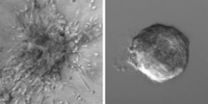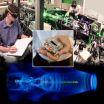(Press-News.org) A new study from Johns Hopkins researchers suggests that the lethal spread of breast cancer is as dependent on a tumor's protein-rich environment as on genetic changes inside tumor cells.
In a report in the Sept. 25 issue of the Proceedings of the National Academy of Sciences, the scientists conclude that a molecular signal in the protein meshwork surrounding the breast cancer cells may provide the critical trigger to initiate the life-threatening process of metastasis to distant sites in the body.
Moreover, their experiments suggest that the environment surrounding a tumor can even coax healthy breast cells to invade surrounding tissue just as cancer cells do, and that a healthy environment can cause cancer cells to stay put and not spread as they usually do.
"The most dangerous aspect of breast cancer is its ability to spread to distant sites, and most tumors are initially unable to do that," says Andrew Ewald, Ph.D., assistant professor of cell biology at the Johns Hopkins School of Medicine and member of the Institute for Basic Biomedical Sciences' Center for Cell Dynamics. Learning more specifically what triggers metastases may provide additional targets for preventing and treating the malignant process that causes cancer deaths, Ewald adds.
It's widely accepted that cancers acquire the ability to spread through the gradual accumulation of genetic changes, and experiments have also shown that these changes occur in parallel with changes in the protein content and 3-dimensional patterning of the protein meshwork that creates their immediate surroundings. What has been unclear is whether those immediate surroundings play a role in initiating and encouraging cancer's spread, or whether they are more "effect" then "cause."
To sort out the contributions of both the genetic changes and the environment, Ewald's team separated tumor cells from their surroundings by taking fragments of human breast tumors and embedding them in two different commercially available 3-D gels, one that mimics the protein meshwork surrounding healthy mammary tissue and another that mimics tumorous mammary tissue.
The gels are tools often used to study tumor invasiveness. The first was made of proteins that normally create a thin layer around healthy breast tissue, acting as a molecular boundary for it. The second was made entirely of a protein, collagen I, which is found in unusually high concentrations around breast tumors.
If cancer cells are driven to disperse solely because of the genetic changes they carry, the researchers expected to see the tumor fragments behave similarly in both the healthy and tumorous environments. What they saw instead, says Ewald, was a distinct difference. As expected, 88 percent of tumor fragments sent cells crawling into the tumorous meshwork environment, the first step in metastasis known as dissemination. (See video: http://www.cellimagelibrary.org/images/42161) But only 15 percent of tumor fragments sent cells crawling into the normal environment. (See video: http://www.cellimagelibrary.org/images/42160) According to Ewald, these results indicate that the environment around a tumor plays a more direct role in cancer spread than previously thought.
If indeed cells can be enticed outward by the protein environment, the researchers reasoned, that environment might even be powerful enough to coax cells away from healthy breast tissue. To test this idea, they took fragments of both healthy and cancerous mouse mammary glands and placed them in the collagen I gels mimicking a tumor's environment. Results show that in the tumorous environment, nearly as many of the healthy fragments sent cells dispersing as did the tumorous fragments. (See videos: http://www.cellimagelibrary.org/images/42151 and http://www.cellimagelibrary.org/images/42152)
One notable difference shown in their time-lapse videos was that healthy cells only exited the normal tissue fragments for a short period of time, while cancer cells continued to exit the tumor fragments throughout the whole test period.
To learn why healthy cells stopped exiting normal tissue fragments sooner, the researchers analyzed the proteins on the cells that were in direct contact with the meshwork gels. In breast tissue, a thin protein layer normally forms a boundary between cells and their environment. When both healthy and tumorous tissue fragments were surgically removed prior to the experiments, this boundary was disrupted, allowing breast cells to directly contact the protein meshwork beyond the boundary. In healthy mammary gland fragments, the team found that the "self-corrective behavior" coincided with the re-creation of this protein boundary.
"This tells us that tumors continue to listen to their environments," Ewald says. "Our data suggest that tumors with genetic changes that favor cancer spread may not disperse until they are within a permissive environment." A dispersal-permissive environment is enough to provoke invasive behavior in all mammary tissue, healthy and cancerous, Ewald explains, and the difference between the two can be a single genetic change that allows the dispersal to continue unchecked.
INFORMATION:
Other authors of the report include Kim-Vy Nguyen-Ngoc, Kevin Cheung, Eliah Shamir and Ryan Gray from The Johns Hopkins University; Audrey Brenot and Zena Werb from the University of California, San Francisco; and William Hines and Paul Yaswen from Lawrence Berkeley National Laboratory.
The research was supported by the Sidney Kimmel Comprehensive Cancer Center at Johns Hopkins and by grants from the National Cancer Institute (R01CA056721, R01CA138818, U01CA155758, U54CA151838, P50CA88843), the National Institute of Environmental Health Sciences (U01ES019458) and the Safeway Foundation Award for Breast Cancer Research.
On the Web:
Link to article in PNAS: http://www.pnas.org/content/109/39/E2595.full
Ewald lab: http://www.hopkinsmedicine.org/cellbio/dept/EwaldProfile.html
Breast cancer cells enticed to spread by 'tumorous environment' as well as genetic changes
2012-10-22
ELSE PRESS RELEASES FROM THIS DATE:
Clue to cause of Alzheimer's dementia found in brain samples
2012-10-22
Researchers at Washington University School of Medicine in St. Louis have found a key difference in the brains of people with Alzheimer's disease and those who are cognitively normal but still have brain plaques that characterize this type of dementia.
"There is a very interesting group of people whose thinking and memory are normal, even late in life, yet their brains are full of amyloid beta plaques that appear to be identical to what's seen in Alzheimer's disease," says David L. Brody, MD, PhD, associate professor of neurology. "How this can occur is a tantalizing ...
State-of-the-art beams from table-top accelerators
2012-10-22
Focusing in on beam focus
The rapidly evolving technology of laser plasma accelerators (LPAs) – called "table-top accelerators" because their length can be measured in centimeters instead of kilometers – promises a new breed of machines, far less expensive and with far less impact on the land and the environment than today's conventional accelerators.
Future LPAs offer not only compact high-energy colliders for fundamental physics but diminutive light sources as well. These will probe chemical reactions, from artificial photosynthesis to "green catalysis"; unique biological ...
Scattered X-rays reveal diseased tissue
2012-10-22
This press release is available in German.
Chronic obstructive pulmonary disease (COPD) is considered the fourth most common cause of death in the United States. Usually the precursor to this life-threatening lung disease is a chronic bronchitis. Partially destroyed alveoli and an over-inflation of the lungs, known as emphysema, are serious side effects. However, the subtle differences in the tissue are barely discernable in standard X-ray images.
In addition to the conventional X-ray images, the Munich scientists analyzed the radiation scattered by the tissue. ...
Fewer patient deaths after surgery in hospitals known for good nursing care
2012-10-22
Patients treated in magnet hospitals (specially designated for their nursing excellence) had 14 percent lower odds of death than those in non-magnet hospitals in a four-state study of 564 hospitals led by the University of Pennsylvania School of Nursing. The magnet designation, determined by the American Nurses Credentialing Center, recognizes high-quality patient care, high levels of nurse education, and nursing innovation.
"Even controlling for differences in nursing, hospital, and patient characteristics, surgical patients fared better in magnet hospitals," said lead ...
Energy-sensing switch discovery could have broad implications for Biology & Medicine
2012-10-22
LA JOLLA, CA – October 21, 2012 – Biochemists at The Scripps Research Institute (TSRI) have discovered a genetic sequence that can alter its host gene's activity in response to cellular energy levels. The scientists have found this particular energy-sensing switch in bacterial genes, which could make it a target for a powerful new class of antibiotics. If similar energy-sensing switches are also identified for human genes, they may be useful for treating metabolism-related disorders such as type 2 diabetes and heart disease.
"This discovery adds a new dimension to our ...
How a fish broke a law of physics
2012-10-22
Reflective surfaces polarize light, a phenomenon that fishermen or photographers overcome by using polarizing sunglasses or polarizing filters to cut our reflective glare. However, PhD student Tom Jordan from the Bristol Centre for Complexity Sciences and his supervisors Professor Julian Partridge and Dr Nicholas Roberts in Bristol's School of Biological Sciences found that these silvery fish have overcome this basic law of reflection – an adaptation that may help them evade predators.
Previously, it was thought that the fish's skin – which contains "multilayer" arrangements ...
A Mississippi river diversion helped build Louisiana wetlands, Penn geologists find
2012-10-22
PHILADELPHIA — The extensive system of levees along the Mississippi River has done much to prevent devastating floods in riverside communities. But the levees have also contributed to the loss of Louisiana's wetlands. By holding in floodwaters, they prevent sediment from flowing into the watershed and rebuilding marshes, which are compacting under their own weight and losing ground to sea-level rise.
Reporting in Nature Geoscience, a team of University of Pennsylvania geologists and others used the Mississippi River flood of the spring of 2011 to observe how floodwaters ...
Improving effectiveness of solar geoengineering
2012-10-22
Washington, D.C.— Solar radiation management is a type of geoengineering that would manipulate the climate in order to reduce the impact of global warming caused by greenhouse gasses. Ideas include increasing the amount of aerosols in the stratosphere, which could scatter incoming solar light away from Earth's surface, or creating low-altitude marine clouds to reflect these same rays.
Research models have indicated that the climatic effect of this type of geoengineering will vary by region, because the climate systems respond differently to the reflecting substances ...
Intermediate glucose control may be better than tight in neurocritical care patients
2012-10-22
A new study in BioMed Central's open access journal Critical Care suggests that intensive glycemic control does not reduce mortality in neurocritical care patients and could, in fact, lead to more neurological damage. Complicating the picture, poor glucose control also leads to worse recovery and should be avoided. This study suggests that a strategy to maintain intermediate glucose levels would contribute to better outcomes in these patients.
Hyperglycemia and hypoglycemia are common in critically ill patients and are strongly associated with worse outcomes. This is ...
Danish researchers release ground-breaking knowledge about calcium pumps in cells
2012-10-22
When animals and plants are exposed to influences such as bacterial attack, odour and cold, calcium ions flow into the cells. The calcium provides the cells with a signal about what is going on outside, but as high concentrations of calcium are toxic to the cells, it must be quickly pumped out again. Researchers from the Danish National Research Foundation's PUMPkin Centre at both the University of Copenhagen and Aarhus University have now shown that calcium pumps in the cell's outer membrane adjust the pump speed very accurately to the calcium concentration. These findings ...



